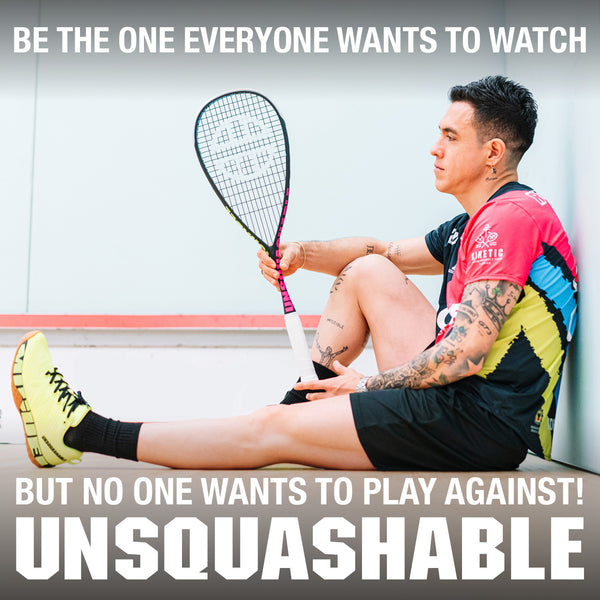Five ways to improve your squash by James Willstrop
February 28 2023

Our aim is to inspire squash players of all standards by helping them to fulfil their potential & gain maximum enjoyment from playing one of the world’s most exciting & healthiest sports.
James Willstrop is one of England’s greatest ever players whose attacking style of play has seen him not only reach the very pinnacle of the game but acknowledged as one of the most respected & popular players of his generation.
We hope that you enjoy reading James' five suggestions of how to improve your squash; from find a friendly club; taking advice from a smart coach; watching & learning from the best players; investing in a physio; & making the most of every session.
FIND A FRIENDLY CLUB
The best place to start is by finding & embracing a thriving squash club or community. You will meet players, glean inspiration & be able to join a league structure where you can compete & improve. You can find training partners & perhaps a good coach who will motivate you to practice & put in the hours required.
There is a social aspect to squash that usually enhances any efforts you make to improve. I now live further away from the squash club where I grew up playing, but I continue to go back there because it’s a warm & friendly club.
We train in groups which adds further to the enjoyment & makes the days when I have to train extra hard or do a double session much easier because of the friendly atmosphere.
SEARCH FOR GOOD ADVICE BUT DON’T OBSESS OVER IT
Try to find a reputable coach or trainer. They are not particularly easy to come by so it’s not a disaster if you can’t find one or afford to pay for it.
People are obsessed with quick fixes & many pay hundreds of pounds a month for a few 40-minute sessions with a coach. High standard coaching is highly effective if you want to keep improving, but no coach in the world does the work for you.
You can improve so much from hard practice, training & putting in the hours yourself. World-class coaches, fancy facilities & equipment are helpful but not essential. Hard work costs nothing but your time & energy – you need lots of that if you want to get better at squash.
Practicing with technical faults is not ideal but there are plenty of world standard players who have reached high levels with what some experts might consider not to be technically correct. If you were to study the top 20 squash players in the world no technique is the same. There is no right way to play the sport because so many have done it so well so differently.
WATCH, WATCH, WATCH
Watch squash. Watch the best players play a lot & compare them to average club & recreational players. See how the best do it & try to discern the difference. When we watch we absorb & try to emulate. When we see & store images & patterns of play we can call on them & take inspiration & ideas from them. It’s almost plagiarism.
Inspiration is hard to come by when your experiences give you nothing to work with. If you’ve seen it, you can draw upon it. Budding singers will listen to Pavarotti; writers will read Shakespeare; tennis players will enjoy watching players such as Rafael Nadal & Novak Djokovic.
And squash? Try watching any of the top players on the PSA World Tour, there are plenty of free videos on YouTube.
If you can, go see the best players in the flesh.
www.psaworldtour.com provides details of professional tournaments around the world & is also a great source for video clips & highlights from the major events.
LOOK AFTER YOUR BODY
Squash places enormous stresses & imbalances on the body. There is a great deal of impact going through joints & muscles in every rally. Prepare the body as best you can with the time you have, in a very specific way. If you only have two chances to train in a week, use them wisely. I’d advise against going for two five-mile runs or doing general weight training as these exercises have little to do with the movements made in squash.
Instead, try circuits, which work many of the different muscles required for squash & improve aerobic & anaerobic fitness. Within these circuits try to do leg strengthening variations – use cables in the gym or medicine balls to do lunges or squats with rotations, encouraging recruitment of a boatload of muscles in one exercise.
Ask someone for advice on doing these exercises correctly. If you can, try to implement yoga & Pilates techniques into your busy week. A strong & healthy body that works economically is what you want. When you have that, you can place demands on it much more readily. If you find yourself training hard, find a physio or massage therapist for regular treatments.
TRAIN, PLAY & PRACTICE AT DIFFERENT INTENSITIES
Make sure there is some direction in every session you do. Your solo practice during your lunch break can be either valuable or useless depending on how you do it. Think about the best ways to spend that time. During much of your practise you will want to work with intent & intensity, because that is what is required in a tough match, so it’s wise to think about what you want to improve during your session.
Try to create a scenario where you concentrate for five-minute spells very intently. Avoid just hitting the ball any old way & thinking about dinner at the same time; make every shot you hit severe & purposeful. Shorten the session if you like but do what you do as well as you possibly can.
Think about the shots or plays that let you down in your previous match & work on them, making your concentration match-like. It’s not easy to do & requires effort. I’ve said it before, anyone can practice badly.
Conversely though, if you are training hard try to incorporate sessions which are easy & not as mentally taxing. Get into a group & simply enjoy it. That’s good for improvement too. If I’m tired after coming back from a hard tournament, I will try to give myself a few days of relaxed practice, where the aim of the sessions is to just enjoy it & have fun.
#beinspired







